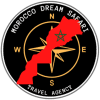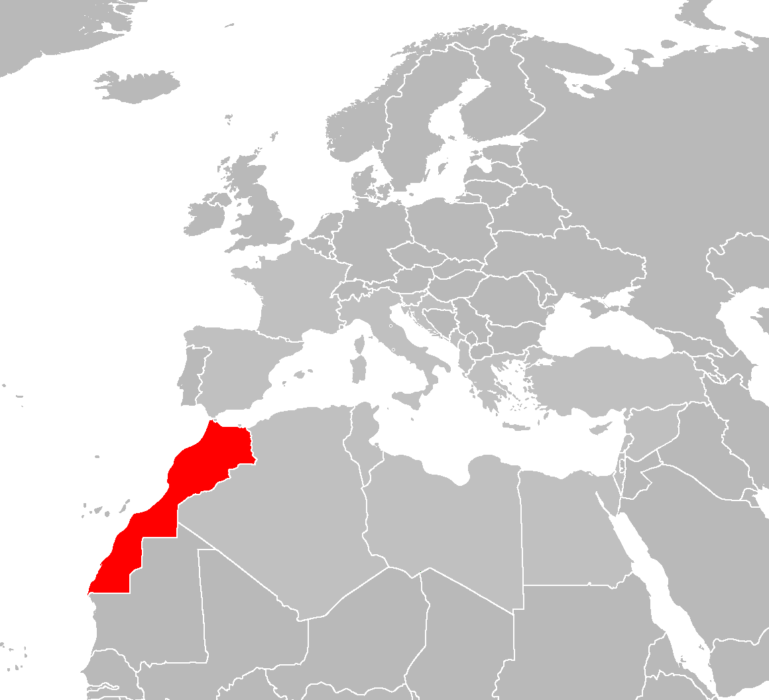Morocco is a fascinating country located in North-West Africa, on the northern edge of the African continent. It lies in the northern hemisphere and is bordered by the Strait of Gibraltar and the Mediterranean Sea to the north, Mauritania to the south, Algeria to the east, and the Atlantic Ocean to the west. Its strategic location makes it a unique cultural and geographical crossroads.
This captivating nation is known for its rich cultural heritage, stunning landscapes, and diverse topography. From its varied geography to its climatic differences and notable regions, Morocco offers a blend of natural beauty and historical significance. Understanding its location on the world map highlights its importance and charm.
Where is Morocco Located on the World Map?
If you look at a world map, you will find Morocco at the very top corner of Africa. It’s located in the northwest, just a short distance from Europe. In fact, Morocco is so close to Europe that the two continents are separated by only 13 kilometers of water at the Strait of Gibraltar. To the east of Morocco lies Algeria, while Mauritania is its southern neighbor. On its northern side, Morocco is bordered by the Mediterranean Sea, and the Atlantic Ocean stretches along its western coast.
This special location makes Morocco a crossroads between different cultures and continents. It has been influenced by African, Arab, Amazigh (Berber), and European traditions. This blend of cultures is one of the reasons Morocco is such a unique and exciting place to visit.
Morocco and the Greenwich Meridian
Geographically, Morocco is located at about 32.75 degrees north of the equator. It is also 6.19 degrees west of the Greenwich Meridian, which is the line that divides the world into eastern and western hemispheres. These coordinates give Morocco a location that is both central and strategic, allowing it to connect easily with countries in Africa, Europe, and beyond.
Morocco’s Maritime Borders
Morocco’s coastline is incredibly long, stretching over 3,000 kilometers. To the north, it touches the calm waters of the Mediterranean Sea, while to the west, it faces the vast Atlantic Ocean. This long coastline is dotted with beautiful beaches, vibrant cities, and busy ports. One of the most famous ports is the Port of Tangier, which plays a vital role in trade and tourism. Morocco’s maritime location has also made it an important meeting point for different civilizations throughout history.
Morocco’s Land Borders
On land, Morocco shares borders with Algeria to the east and Mauritania to the south. However, Morocco also faces three Spanish territories across the Mediterranean—Ceuta, Melilla, and the small rocky island of Perejil. These close connections with neighboring countries and territories have shaped Morocco’s culture, politics, and economy over the centuries.
Why Morocco’s Location Is Important
Morocco’s geographical location gives it several advantages:
- Close to Europe: Morocco is one of the closest African countries to Europe. This proximity has made it a key player in trade and cultural exchanges with European countries.
- Gateway to Africa: Morocco is often called the “Gateway to Africa” because of its position at the northern tip of the continent. It serves as a bridge between African and European markets.
- Tourism: Its diverse geography and cultures attract millions of tourists every year. From the Sahara Desert to the Atlas Mountains, Morocco offers a wide range of experiences.
- Natural Resources: Morocco’s strategic position also allows it to make the most of its natural resources, including its rich agriculture and growing renewable energy sector.
Morocco has used its location to grow economically and culturally. For example, the “Tangier Med” port is now one of the largest in the Mediterranean and has significantly boosted trade. The country’s openness to Europe and Africa has also helped attract foreign investment.
Traveling to Morocco
If you’re planning a trip to Morocco, the good news is that it’s easy to get there. Many citizens from Arab countries and the European Union can visit without a visa. They only need a valid passport or an identity card for a short stay. For those who do need a visa, the process is straightforward. You can visit a Moroccan embassy in your country to complete the required paperwork.
Morocco is well-connected by air, with major international airports in cities like Casablanca, Marrakech, and Tangier. Flights are available from Europe, the Americas, Asia, and other parts of Africa. Once you arrive, getting around is convenient thanks to Morocco’s modern transportation network, which includes trains, buses, and domestic flights.
Morocco’s Major Cities and Distances
When traveling in Morocco, it’s helpful to understand the distances between its major cities. Here are a few examples to give you an idea:
- Rabat to Casablanca: Rabat, the capital, is about 87 kilometers from Casablanca. It takes just over an hour to drive between the two cities.
- Fez to Meknes: These two historic cities are close to each other, with a distance of about 64 kilometers. A drive takes less than an hour.
- Marrakech to Agadir: The drive from Marrakech to the coastal city of Agadir takes about three hours, covering a distance of roughly 258 kilometers.
- Tangier to Chefchaouen: Tangier, in the north, is about 113 kilometers from the charming blue city of Chefchaouen. The journey takes a little over two hours by car.
Morocco’s cities are well-connected, and you can easily explore different regions during your visit. Trains and buses are affordable and efficient, making it simple to travel between popular destinations.
Morocco’s Culture and Diversity
Morocco is not just a place on the map; it’s a land rich in culture, history, and diversity. Its people come from many backgrounds, including Arab, Amazigh (Berber), and African origins. This mix of cultures is reflected in Morocco’s languages, traditions, and way of life.
Languages
Morocco has two official languages: Arabic and Amazigh. Most Moroccans speak Darija, a dialect of Arabic used in daily life. French is widely spoken, especially in business and government, while Spanish is common in northern areas. English is becoming more popular, particularly among young people.
Religion
Islam is the main religion in Morocco, with over 98% of the population identifying as Muslim. However, the country is known for its religious tolerance. Small Christian and Jewish communities also live in Morocco, and the constitution guarantees freedom of worship.
Morocco’s Economy and Development
Morocco’s economy is one of the strongest in Africa. Agriculture is a major sector, employing about 40% of the population. Industry, including manufacturing and mining, makes up a significant part of the country’s income. Services, especially tourism, also play a crucial role.
In recent years, Morocco has focused on renewable energy. The Noor Power Station in Ouarzazate is one of the largest solar power plants in the world. Projects like this show Morocco’s commitment to sustainable development.
Weather in Morocco
Morocco’s climate varies depending on where you are. The coastal areas have a Mediterranean climate, with hot, dry summers and mild, rainy winters. Inland, temperatures can be extreme, especially in the desert, where summers are scorching and winters are chilly. If you visit the Atlas Mountains, you might even see snow in winter.
Frequently Asked Questions
Morocco is in North Africa but has close ties to Europe due to its proximity to Spain across the Strait of Gibraltar.
Morocco has a Mediterranean climate in the north, a temperate Atlantic climate along the coast, and a desert climate in the south.
Morocco is home to the Rif, High Atlas, Middle Atlas, and Anti-Atlas mountain ranges.
Morocco is very close to Europe, with only 14 kilometers (9 miles) separating it from Spain across the Strait of Gibraltar. Ferries connect Tangier in Morocco to Spain in less than an hour.
Morocco is home to a variety of wildlife, including gazelles, Barbary macaques, eagles, fennec foxes, and the endangered Barbary leopard. Many of these species are found in protected areas or mountainous regions.
Morocco’s coastline supports thriving ports and fishing industries. Its fertile plains drive agricultural production, while the mountains and desert regions attract tourism. Additionally, its location at the crossroads of trade routes boosts commerce with Europe, Africa, and the Middle East.
Yes, Morocco is a free and independent country. It has its own government and a constitutional monarchy led by King Mohammed VI.
Morocco is famous for its rich culture, delicious food, and stunning landscapes. Popular attractions include the Sahara Desert, the blue city of Chefchaouen, and the bustling markets of Marrakech.
Discover Morocco
Morocco is more than just a point on a map. It’s a country full of life, color, and adventure. Whether you’re exploring ancient cities, enjoying the natural beauty of the Sahara Desert, or experiencing its vibrant culture, Morocco has something for everyone. Its strategic location and rich history make it a must-visit destination for travelers from around the world.to discover the magic of this North African country!


Leave a Reply